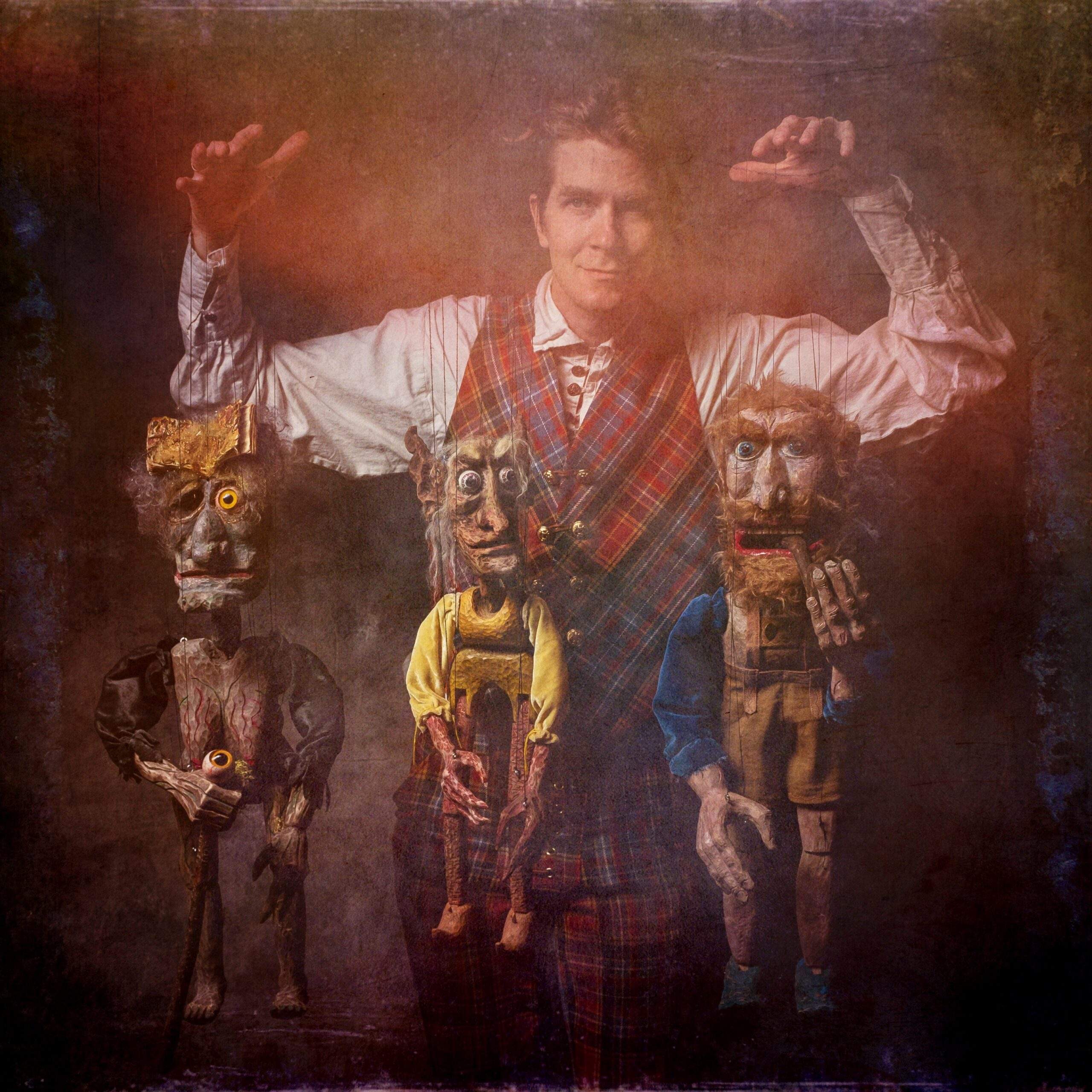Dalrymple and The Wild Daimons | Interview | “Bringing drama, theater, music and puppetry to the stage”
Dalrymple and the Wild Daimons are a psychedelic/rock/neo-classical/chamber-doom band. This ensemble brings drama, theater, music and puppetry to the stage.
Dalrymple himself is a mystic seeker and a seer of sound. This man wrote an album called ‘Make Believe’ for those of you who have had a traumatic and troubled childhood. Let the music wash over you in shades of green. Take the journey! Follow Dalrymple and the Wild Daimons into the electric future. – David Bixby Performing Arts.
If Dalrymple MacAlpin hung a shingle out that had one word telling the world what he was about, that word might be “storyteller.” MacAlpin tells his stories through various mediums, the primary one being music, but he also works in theater, puppetry, and more recently has entered a collaboration with an illustrator to produce a graphic novel.
MacAlpin taps into deep roots in the Bardic tradition, the remembering and communicating of songs, stories and poems over centuries of time, and marries that with a contemporary world view, right here, right now, in your face. Dalrymple and the Wild Daimon’s latest single, the Stooges, MC5, Detroit proto punk influenced, Blood on the Concrete, released a couple of months ago, evokes the harsh reality of violence in America today making a strident soundtrack for the senseless mass shootings happening nearly every day. Way too much blood flowing on the concrete. The song effectively communicates the terror of the situation along with the limp response toward solving the problem.
Another function of storytelling is to introduce different worlds, or to be a bridge between worlds. A simple musical refrain can serve as a comforting thread through the chaos of unknown territory like that of death. It can serve as a touchstone, a little piece of home to take on the journey. When we started mixing Blood on the Concrete, I mentioned to Dalrymple that a well-known local figure, Mikail Graham, was in the hospital with a terminal illness and near death. I didn’t know they were close friends and that he was unaware. Graham was a giving genius. When Dalrymple was studying music composition in college and ran into a technical roadblock, Mikail would help him sort it out with his musical expertise.
Dalrymple left the mix session early in a mild state of shock. Fortunately, he was later able to visit Mikail in the hospital and sing him a Yeats poem, I believe, to help him on his way. I share this story to show the work of a real storyteller in action. – Oz Fritz
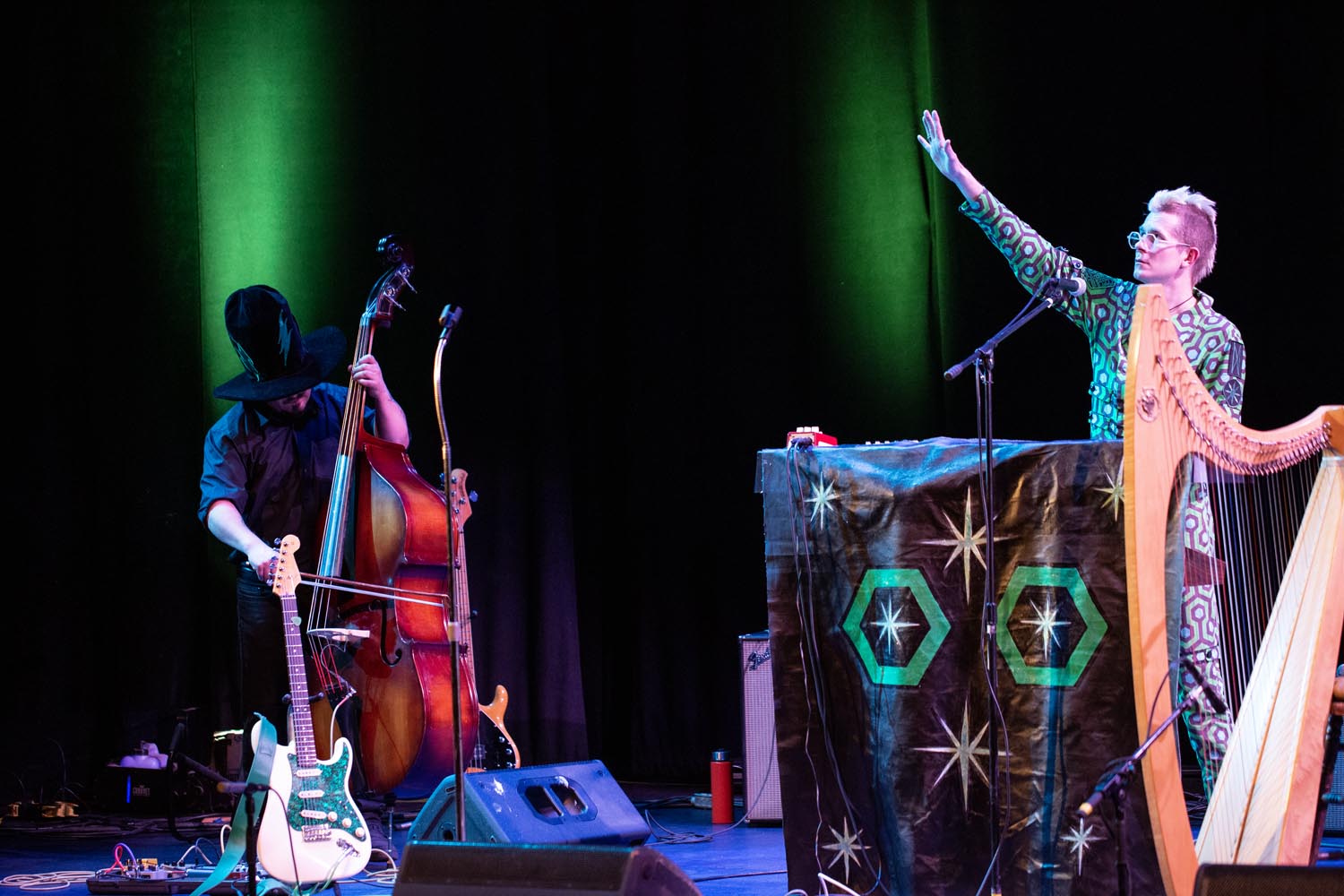
Where did you grow up and when did you first start playing music?
Dalrymple: Growing up in the great lakes state of Michigan, I called the Detroit “burbs” my home sweet home. You know the kind of moldering decay, the insufferable rot that creeps into the crumbling brick and mortar until urban and rural become inseparably intertwined with one another? That’s mother nature’s poetic justice on display and that’s where I grew up. I was drawn to music very early on but swapped my air guitar for an electric Fender Strat at the vulnerable age of 12 and immediately began classical guitar lessons down at Southgate mall from a guy named Phil. My friends and I were convinced Phil was actually Kurt Cobain hiding out in disguise after faking his “suicide.”
As a prolific multi-instrumentalist, what are the instruments that you play the most? Do you have a favorite instrument to play?
Before I ever had a physical instrument to play, I had my voice and so I consider that the first and foremost of my instruments. I recall being alone in the woods, singing at the top of my lungs like some sort of oddball opera diva, there were no words involved, just the creation of sound at this point. I wasn’t exposed to opera as a kid so I’m not clear where these vocal ideas came from, but you don’t ask questions when you’re a child, you exist without explanation.
Guitar was the first, outside of my body, instrument and so holds the nostalgic place in my heart as a first-born child in a family unit might. I began with harp in high-school after delving into Druidic magick and suddenly my sole ambition was to grow up and become a wandering bard, weaving mythical, musical spells whilst living in the remote, misty green hills of Ireland. Somehow that misty green hill turned into a dilapidated, 15-bedroom anarchist co-op in Oakland, California. Oh humorous destiny! The plus side was that this punk-rock squatter paradise boasted a graffiti laden grand piano in the downstairs living room and I occupied its weathered bench seat for countless hours. It is the quartet of these four instruments that I have dedicated my life to studying and improving upon.
I really like the eclecticism and variety of styles/genres present in your music; from spacey psychedelic rock to traditional sounding medieval folk music and all sorts of things in-between. How would you describe this progression of your music?
I have had the mindset of a seeker when approaching music and art. The allure of creating music morphs quickly into intoxication when you first discover that you’re cavorting in an infinite playground, a place to explore the supreme limitless cosmos with as much radical, extreme freedom as you dare. I do admire certain bands who have a specific sound and get really good at one particular genre. Maybe I will try that one day, however, in the meantime I am having too much fun experimenting with the alchemy of sonority, just as all musical opportunists before me have. That said, the new band I have put together, Dalrymple and the Wild Daimons, is an obvious progression of my past musical output and is intentionally being distilled into a cohesive expression which incorporates what I think is, “the best of” my past repertoire.
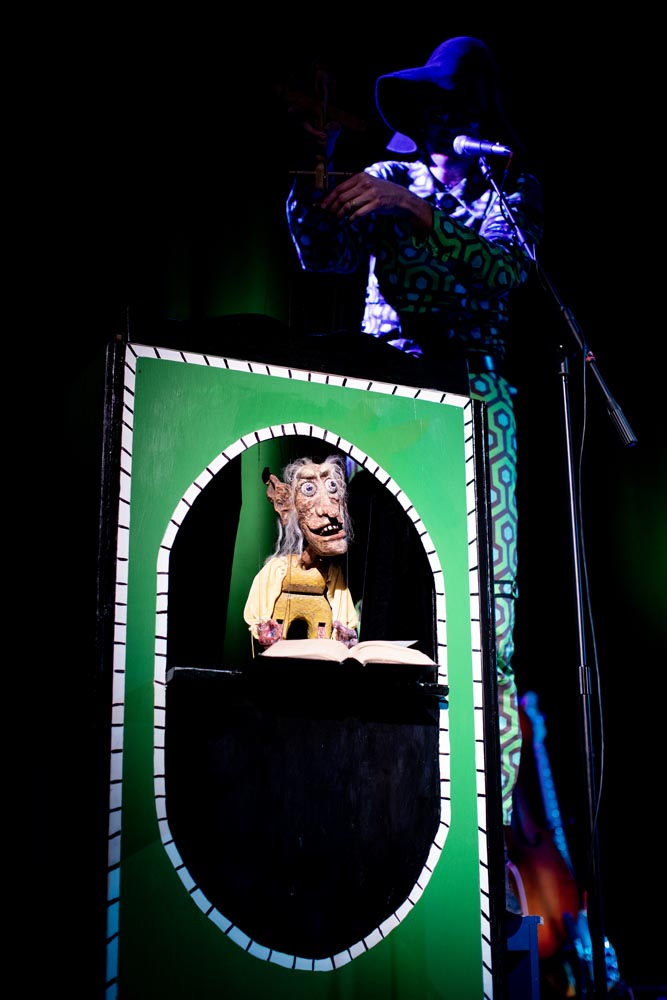
How and where do you find the source of inspiration behind your music?
There is no easy, straight answer to this question because the creation of art is such an ephemeral, magical and individual process. However, I have named my band, Dalrymple and the Wild Daimons after the Greek word for provider/divider of destiny/fortune, i.e. The Daimon. If you can personify your individual inspiration and creative destiny and communicate with it, you have found the key to your Daimon. For myself this is a green levitating alien-being created from outer space star portals, green icicles and blue wings, his name is Kozmar. He lives in another dimension called Ozglazemotheiginiginiginiginiginnineand has been with me always, though it was not until the age of 17 that I first clearly saw him with my psychedelic destiny sparkling in his hexagonal eyes. I have always felt plugged into this source of a cosmic muse throughout my life and when the form it takes decides to change, I become a willing, mutable participant in the supernatural game of tag. As the Jungian psychologist and scholar, Marie-Louise von Franz said when referring to active imagination, “One may deliberately enter into contact with the unconscious and make a conscious connection with psychic phenomena.”
I have found this psychic phenomena, or Daimon if you will, to be a highly responsive intelligence, an entity that lies somewhere between devil and divinity, between substance and dream. Reach out and hold nothing back and the restorative balm of your imagination will do the rest.
Which artists have influenced your work more than any others?
Certainly, the answer has changed depending on the era in question, but starting at the beginning I will admit to the following:
As a Detroit boy, Motown was my earliest musical love, The Temptations, The Supremes, The Jackson Five and Stevie Wonder. The Texas born Caruso of Rock, Roy Orbison also made an indelible mark on my impressionable psyche. The Righteous Brothers, Bob Dylan and Neil Young were all heavily rotating staples in my household. This was all before I began to play music but their influence is never-the-less a strong part of my tonal makeup.
Nirvana was the first band I really got obsessed with, in fact, my first band was a Nirvana cover band and it wasn’t until I realized that my originals were sounding a lot like Kurt’s that I stopped with the covers and dedicated myself solely to playing original music. Kurt Cobain was the reason I began playing guitar in the first place and so his music will forever hold a source of inspiration to me. I decided to recently cover their song, ‘Dumb’ with my current band. It was certainly not a mid-life regression that dictated this decision, rather I felt as the salmon returning to spawn at the place of its conception. “I’m not like them but I can pretend…”
When my high school years came it was the classics, The Velvet Underground, Syd Barrett, Ozzy, The Beatles, Led Zeppelin, The Doors, Pink Floyd, Black Sabbath and King Crimson who I obsessed over HEAVILY. Each of these bands held first place for me at one point or another. Then David Bowie, Bauhaus, Dead Can Dance, Radiohead, PJ Harvey, The White Stripes, Joy Division, The Cramps, Talking Heads and The Clash became the favorite bands of my early 20’s when forming my first band, Y KILL K.
Nick Cave and the Bad Seeds, Tom Waits, The Incredible String Band, Robin Williamson, Swans, The Flaming Lips, Einstürzende Neubauten, Yes, Diamanda Galas, Sequentia, Can, Amon Düül II, Eloy, The Residents, Psychic TV, Ange, Tangerine Dream, Popul Vuh, Nina Hagen and Comus became heavily rotating staples during my Lasher Keen years, 2006-2016.
Jazz started creeping in around this time with artists such as Miles Davis, John and Alice Coltrane, Sun Ra, Dorothy Ashby, Pharoah Sanders and Thelonious Monk further expanding my growing musical vocabulary.
The German composer, Carl Orff has inspired me tremendously with his enormous body of work. I went to college for 4 years in my early 30s to study music composition/theory and vocal training and embarked on a European puppet tour of the Czech Republic and Germany where I studied at the International Puppets in Prague Academy in order to learn the traditional art of Czech marionette carving. All this was inspired by the music of Carl Orff. I delved deep into classical music at college and became enamored with the works of Stravinsky, Debussy, Schubert, Veljo Tormis, Terry Riley, Moondog, Bartok, Igor Wakhevitch, Liszt, Beethoven, Bach, Greig, Penderecki, John Cage and Ligeti. The avant-garde really began altering my perceptions of how the artform of music can be pushed beyond the building blocks of harmony, melody, rhythm and timbre and become something else entirely, transmogrifying into some new language, barbaric, intellectual and venomous.
I am constantly seeking out and discovering new music, like an alien race scouring the edges of the galaxy for its sustenance, I find planets of punk, classical, metal, jazz, medieval, pop, electronic, hip-hop, folk, new wave, old wave, experimental, psychedelic, doom, minimalist, maximist, and I devour them all because amazing music transcends the stereotypes of genre. Current records on the turntable this week are ‘Daddy’s Homeby’ by St. Vincent, ‘Starsailor’ by Tim Buckley, ‘Stranded’ by Roxy Music and Thom Yorke’s soundtrack to the 2018 remake of ‘Suspiria’.
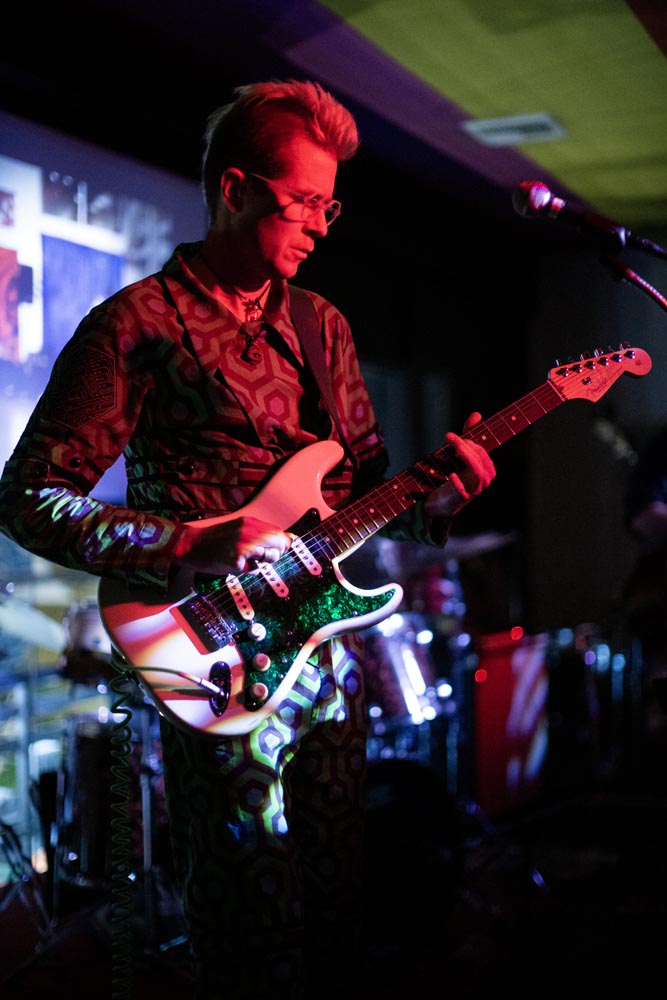
You have collaborated with many artists/musicians over the years. Are there any specific ones that you just really just ‘clicked’ with?
Drag City recording artists, Dawn McCarthy and Nils Frykdahl of Faun Fables and Sleepytime Gorilla Museum/Free Salamander Exhibit are the two artists I have collaborated with the most. They appear on almost all of my records to date as guest musicians and I have played more shows with them than any other band. There is always a definite spark when working with these highly proficient artists. Other musicians I would have to include in the spark category would be Cornelius Boots of The Edmund Welles Quartet, Markus Wolff of Crash Worship/Waldteufel and the basso profundo opera singer John Ames, who not only collaborated with me on my last record, but whom also became my voice coach, imparting some valuable operatic vocal techniques in between tours of Mozart’s Requiem.
I have worked with the Grammy winning producer and engineer Oz Fritz for many years. I feel extremely fortunate to have at the helm of the mixing board the same recording engineer who worked with Tom Waits, John Hammond, Iggy Pop, Bill Laswell and John Zorn among many others. This is a collaboration which is continuing presently as Oz is currently recording/mixing the latest series of songs for Dalrymple and the Wild Daimons.
Your album ‘Make Believe’, lists well over a dozen musicians in the credits. What was it like getting this many musicians together and recording the album?
Alejandro Jodorowsky succinctly states in the 2013 Dune documentary, ‘Ambition, Yes!,’ when referring to his aspiring film project of the same name. My response to seeing this veritable, vigorous appetite for art on the big screen was enthusiastic, I CAN DO THIS.
I had the inkling of ancient wishes turning into physical reality before my eyes when building the world of ‘Make Believe’. It was a live musical theatre stage play involving many actors, musicians and stage crew in addition to a double album that had over 30 musicians on board. It was not always easy to navigate between roles of musician, director, actor and general organizer of this spectacle but the recording of the album was a more forgiving process. I was at the time adopting my music composition and theory training to a batch of songs I had written before I “learned music.” This made for some unexpected, but eclectic sounds to emerge. What would harps, bassoons, bass clarinets, trumpets, cellos, violins, opera vocalists and medieval children’s choirs sound like flirting with drum sets, guitars, Moog synthesizers and maniacal chants from Roald Dahl’s Charlie and the Chocolate Factory? I finally got my answer when the record came out. Although the ambition for ‘Make Believe’ became realized and was a very rewarding process, I am working on distilling a vision with my current project which requires fewer individuals to pull off.
“The nearer one comes to the essence of the statement, the nearer to absolute simplicity, the more immediate and powerful is the effect.” -Carl Orff
What is the ‘why’ behind why you do what you do?
Until recently, I had never mused over this question in a conscious way. However, there comes a time when one attempts to penetrate the self, trying to gain clarification and so you ask, why have I dedicated my life to making the kind of music I have? Quite honestly, I believe it was the path I chose for myself as a spirit before I was born on this earth. My “why” has woken up from the slumber of blurred bewilderment to reveal its true nature at last. I have formulated the answer to a mission statement for myself and the musicians collaborating alongside me.
“To save as many Daimons as we can from being ignored, repressed and annihilated, using the divine electricity that courses through the cosmic fields of music, art, theatre, magick and the power of active imagination. Today is the first day of the rest of your mythology.”
The greatest gift I receive as a performer is after a show when a fan comes up to me with that sparkle in their eyes and they express how they can’t wait to go home and do something, create something with whatever it is they have gotten out of the performance. Call it inspiration or insight, it returns full circle for this kind of connection to my audience is what inspires my work to continue and evolve.
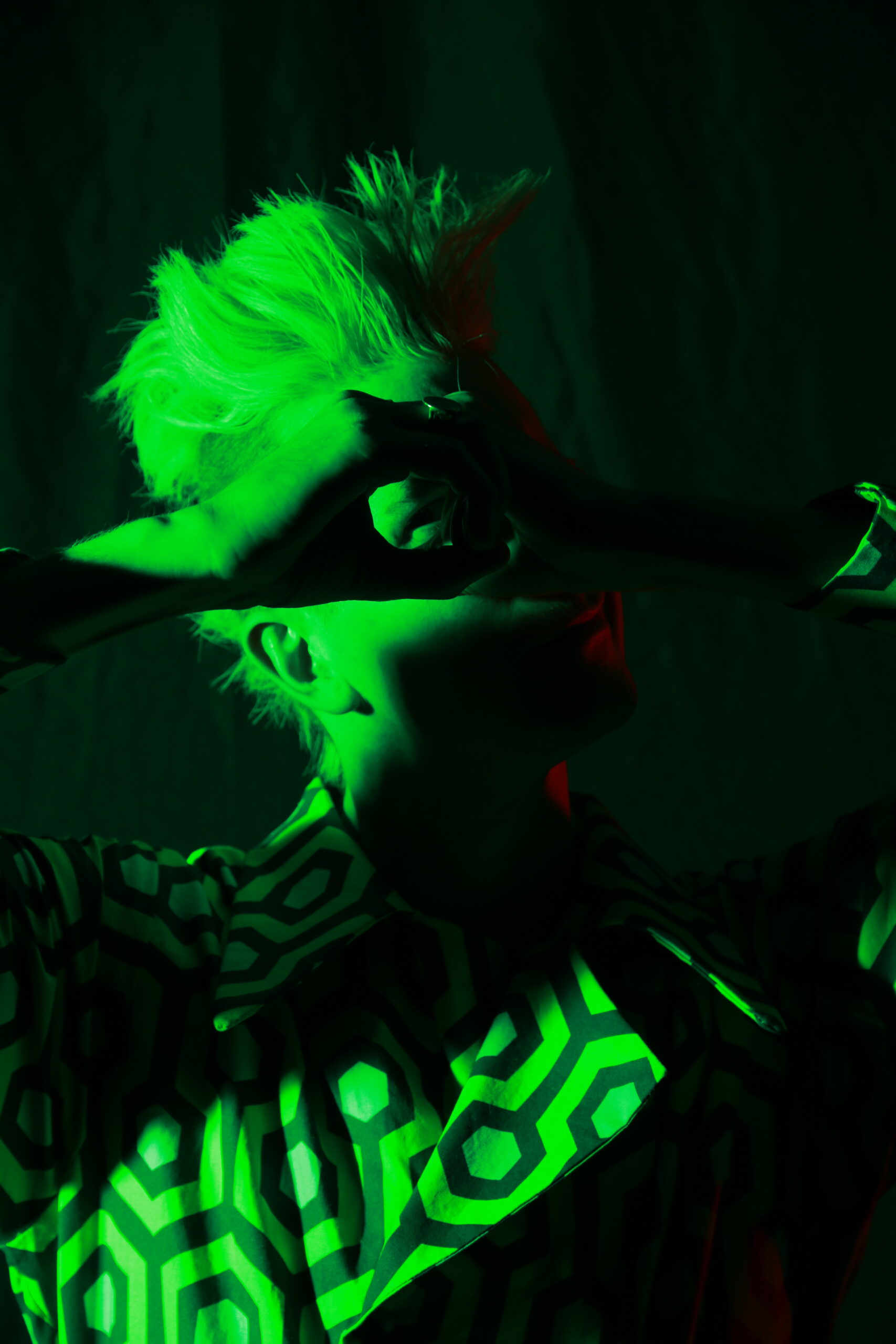
Your latest track on Bandcamp, ‘Blood on the Concrete,’ and a few other live songs I heard on YouTube, seem to have a much heavier psychedelic sound than some of your previous work. What caused this change in direction?
A return to my Detroit roots! A lot of people feel the need to escape where they come from, to rebel against the conformity of the familiar and strike out towards something completely foreign to their upbringing. I was no exception to this rule. Unconsciously, I fathomed the furthest thing from high energy Detroit rock and roll must be esoteric, mythical folk music, which was my previous bands, Lasher Keen’s consistent oeuvre. Then long ago and far away but right next door to yesterday, the stars aligned in the shape of a green hexagon and a cosmic storm of ultimate destruction annihilated my antiquated fortress of mythic solitude.
Yes, Kozmar came back into my life and everything changed. I mean everything. It was the energy of my Daimon, seething through the folds of my flesh and spirit, which quite suddenly directed the course of my soul’s ship toward the shore of… Detroit rock city. You see, my father managed a proto-punk Detroit rock band in the late 60’s and early 70’s called, The Dogs. You’ve heard of the MC5, The Stooges, John Sinclair, but I’m talkin’ about the mother fuckin Dogs, man! The decibel breaking primal squall of chaos that was the lightning in a bottle for Detroit at that time. My father was part of it, the radical political poet, the resident instigator of what he calls, The True Revolution. You can’t escape where you come from and I tried for as long as possible, but I have found my way back home. The music I am writing now incorporates the classical elements, the mythical elements, the esoteric psychedelic elements, but I am intentionally orchestrating the sound with an undercurrent of heavy, palpable, rock electricity because this is who I am. This is where I come from. Why should I deny the roots that gifted me with such fruits?
Is this a direction you will continue in and will we see a full album of this work?
This change in direction was exactly what I needed as a musician and an artist. There are already two albums of this material in the works. My hope is that the first record, ‘We Are God’s’, will be out in the later part of 2023.
How do you see the art of music progressing in the future?
I read in the book, Music: Its Secret Influence Throughout The Ages, that the inspired musician/composer, through the medium of musical vibration and expression, helps to mold the characteristics of the future. It goes onto explain that innovation in musical style has invariably been followed by innovation in morals and politics and that the decline of music in Egypt and Greece were followed by the decline of those once triumphant civilizations. Now I always see the glass as half-full and so my hope for the future of music is that it never stops pushing the boundaries of what is possible and impossible, that it departs from the rules we have laid out and creates new ones as a result. Lest the world as we know it perish in the rubble of stagnation, it is our responsibility as music makers to fly the freak flag of unbridled passion and never once look back or care if anyone is listening.
Your music is not simply music; it is tied together with visual arts, storytelling, performance, and theatre. You are even writing a graphic-novel at the moment. What can you tell us about this and how is it tied into the band?
The forthcoming graphic novel is an extension of my above-mentioned mission statement and a way to turn the band into a conceptual art project of sorts. The story encompasses the perennial human mysteries of life after death, the origin of ideas and inspiration and the questions of destiny and free will.
The idea for this graphic novel series was formulated after reading a short chapter at the end of Plato’s Republic called, The Myth of Er. Here Plato describes the death of a warrior in battle and his experiences in the great beyond. The warrior is miraculously restored to life and is able to recall the series of events that lead a soul towards physical birth. To put it in a metaphysical nutshell, before we are born our soul chooses a purpose to fulfill here on earth and after this purpose is chosen it becomes ratified and made irreversible by the 3 Moirai (Fates) who send the soul with a Daimon to be the guardian of its life and the fulfiller of its chosen destiny. The soul then drinks from the river of Lethe (forgetfulness) which flows from the cave of Hypnos, (sleep) and those who are not saved by wisdom drink more than is necessary, for the river Lethe obscures the memory when one tries to recollect the numinous experience of a pre-birth state.
My idea for the Wild Daimons graphic novel is that a Daimonicinner calling is something a lot of people are tapped into undeniably as children but then repress, ignore and sometimes even abuse as they get older. The Daimons can only take so much of this abuse and they grow weary of their destiny imparting duties, transforming into feral, wild and demonic entities. As a result, human evolution is in dire jeopardy. It’s up to a band of psychedelic, avant-rockers, from an obscure little town outside of Detroit Michigan called, St. Eerie, to set the world right and reunite human beings with their Daimons, one song at a time.
The other theatrical medium I am involved in with this project is puppetry. When I saw the 1989 film, Puppet Master, as a youngster, I knew I wanted nothing more than to carve my own puppets and stage surreal, mind-altering shows with a panorama of home-made marionettes. The fact that I am doing this now as an adult makes me realize just how powerful those early impressions on our young nubile minds really are. Rumpelstilzchen was the first puppet I carved while in Prague and has become my alter-ego in live performances. When he talks, HE is talking, not me. It can get quite freaky. I am currently working on a psychedelic puppet rock opera incorporating several small puppet theatres on the stage next to each musician in the band. The puppets will be live projected on a back screen so they can more easily be seen by a bigger audience.
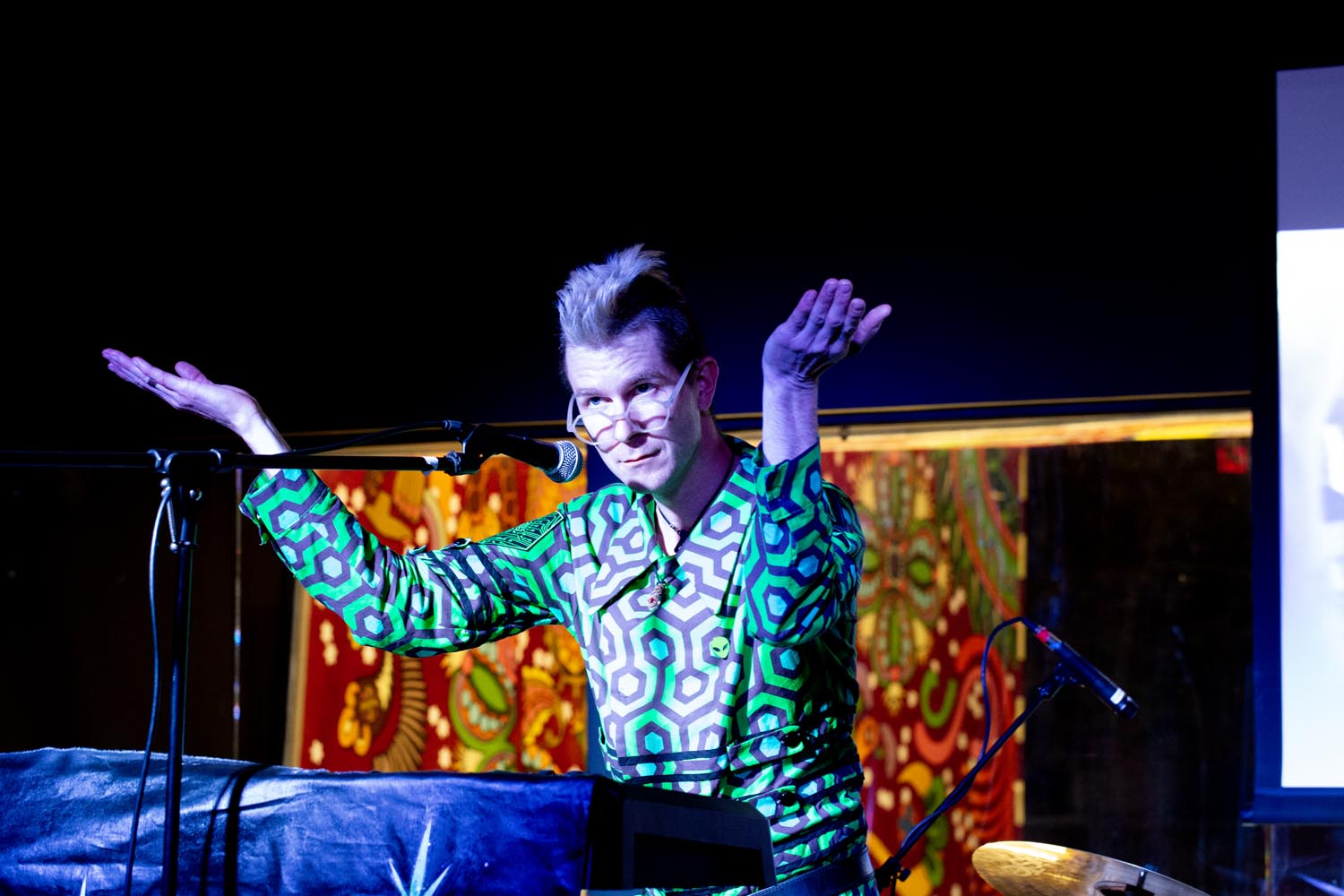
Any last words for readers?
The source of passion which fuels personal creativity is a gift that is meant for everyone. My intention is to start a cosmic conversation with humanity, using music, comic-books and yes, puppets, in order to communicate the idea that, We Are Gods! We are powerful beings capable of extraordinary, face-melting feats of imagination that can change the world. When a kind of individual transformation for the better occurs, a potent connection is formed between you and the, “other you.”
“There is a madness needed to touch the Gods, yes this is true. Few mortals possess it, the willingness to step away from the protection of sanity. To walk the wild woods of madness…” – Neil Gaiman, The Kindly Ones
“When your Daimon is in charge, do not try to think consciously. Drift, wait and obey.” – Rudyard Kipling
“There was a Daimon in me and in the end its presence proved decisive.” – Carl Jung
We are powerful beings capable of extraordinary, face-melting feats of imagination that can change the world, even if that world is our own personal one.
Headline photo: Angela Holm
Dalrymple and the Wild Daimons Official Website / Facebook / Instagram / Bandcamp / YouTube

